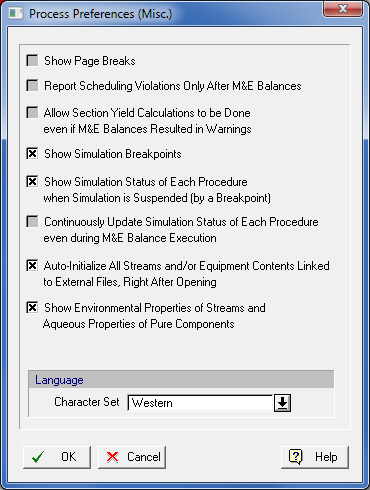

This dialog appears when you select Preferences } Miscellaneous from the flowsheet’s context menu or when you select Edit } Process Options } Preferences } Miscellaneous from the application’s main menu. It lets you specify some not-so-frequently used preferences kept by the process.
•Show Page Breaks:
Turn on this option to display directly on the flowsheet the boundaries of pages.
If this option is checked, then the application will display on the flowsheet the boundaries of pages as a red dotted line. This marking may help the designer rearrange the location of icons and / or streams so that when printed on the selected paper size and orientation the drawing is not broken up in unexpected (or undesirable) locations.
•Report Scheduling Violations Only After M&E Balances:
When a scheduling violation is detected (e.g. equipment sharing violation) the application will report it right after the scheduling calculations are executed. The calculations normally are executed after:
the end of M&E balance calculations,
exiting an operation’s i/o simulation dialog with OK
exiting a procedure’s data dialog with OK
exiting an equipment's data dialog with OK
exiting the process’s scheduling information dialog with OK.
refreshing the contents of any scheduling chart (operations Gantt chart, equipment occupancy chart, etc.)
If you don’t want to be bothered with the announcement of any scheduling conflicts after the closing of any of the dialogs mentioned above, then simply check this choice. You will only be notified of any scheduling conflicts after the conclusion of the M&E balance calculations.
•Allow Section Yield Calculations to be Done even if M&E Balances Resulted in Warnings:
The yield calculations around each section, involve the mass flows and mass fractions of components on streams entering or exiting the section. If the M&E balances ended with errors or warnings there is a good chance that at least some of the yield calculations do not lead to valid fractions. Normally, SuperPro Designer will skip those calculations if errors and/or warnings were encountered during the execution of the M&E balances (for efficiency reasons). If you wish to have those values calculated regardless of the presence or absence of warnings/errors, then you should turn on the related preference.
•Show Simulation Breakpoints:
When placing a breakpoint in or around a unit procedure (see Simulation Breakpoints), normally the application displays an indicator such as  on if the breakpoint is active, or
on if the breakpoint is active, or  if the breakpoint is inactive. If you don’t want the application to display such indicators, then you should turn this feature off.
if the breakpoint is inactive. If you don’t want the application to display such indicators, then you should turn this feature off.
•Show Simulation Status of Each Procedure when Simulation is Suspended (by a Breakpoint):
When the simulation engine pauses after running into a simulation breakpoint, the application normally displays under every procedure an indicator to signify the status of the calculations in that procedure (e.g. a breakpoint in or around a unit procedure, normally the application displays an indicator such as  to signify that all operations have been simulated successfully in that procedure, or
to signify that all operations have been simulated successfully in that procedure, or  if procedure has not been visited yet by the simulation engine (for more details, see Simulation Breakpoints). If you don’t want the application to display such indicators, then you should turn this feature off.
if procedure has not been visited yet by the simulation engine (for more details, see Simulation Breakpoints). If you don’t want the application to display such indicators, then you should turn this feature off.
•Continuously Update Simulation Status of Each Procedure even during M&E Balance Execution:
Normally, the application will not update the simulation (calculation) status of each procedure until the engine runs into a simulation breakpoint. If you wish to see the status indicators change dynamically (as the simulation progresses) then you should turn this feature on. Turning this feature on, along with the next (‘Slow down simulation speed’) may have the combined effect of visually following the sequence of solution as followed by the simulation engine.
•Auto-Initialize All Streams and/or Equipment Contents Linked to External Files, Right After Opening a Process File:
Sometimes it is necessary to link the initialization of an input stream to the contents of another stream in the same or another file (see Auto-Initialization of Input Streams); similarly, instead of having equipment starting the simulation with contents simply be air, you may have designated the contents to be copied from the contents of another equipment in the same or another file (see Contents). If you turn on this feature, any such links get activated and executed right upon opening of the process file.
•Show Environmental Properties of Streams and Aqueous Properties of Pure Components:
This option will allow the user to show or hide the Environmental Properties tab (Bulk Stream Dialog: Env. Properties tab) from all stream dialogs and the Aqueous tab (Pure Component Properties Dialog: Aqueous Tab) from the Pure Component properties dialog.
•Language
Here you can set a specific language preference in the case where you are typing in names in other than english or latin characters. This option will help users using Greek, Japanese, Chinese etc character sets to view their language correctly. By default it starts as ‘Western’. Here the language option is file specific whereas in the Application Settings Dialog: Miscellaneous tab it is saved as an environment variable in the windows registry.